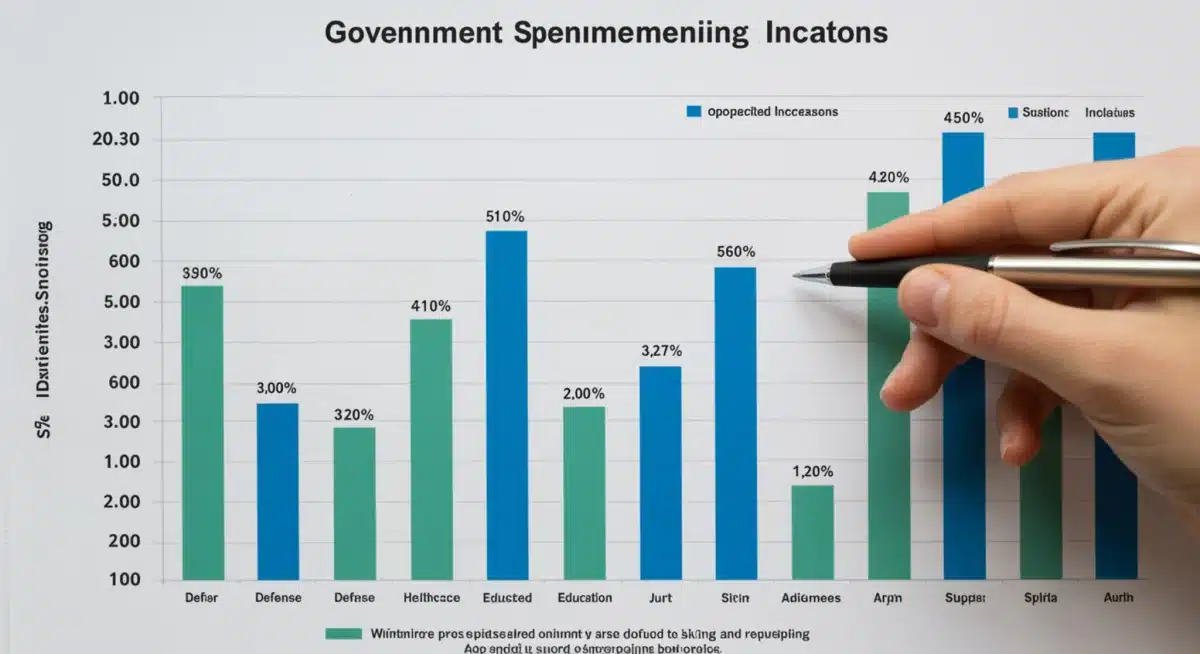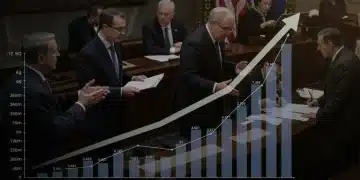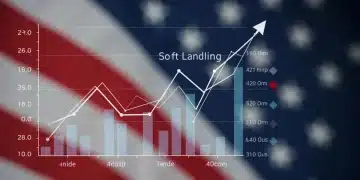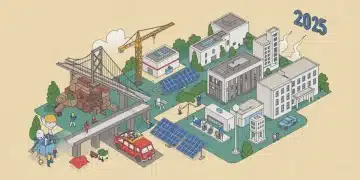5% Inflation: Impact on 2025 Budget Negotiations

The current 5% inflation rate will significantly influence the 2025 budget negotiations by escalating government program costs, altering revenue forecasts, and intensifying fiscal policy debates over spending and economic stability.
Will the current 5% inflation rate influence the 2025 budget negotiations? This question looms large over Washington, D.C., as policymakers prepare for another round of intricate fiscal planning. The persistent upward pressure on prices, currently hovering around 5%, is not merely an economic statistic; it’s a powerful force capable of reshaping the entire landscape of federal spending, revenue projections, and the political will behind critical programs. Understanding its potential impact is crucial for anyone monitoring the nation’s economic future.
The economic backdrop: understanding 5% inflation
The current 5% inflation rate presents a complex and multifaceted challenge for the U.S. economy, setting a critical stage for the upcoming 2025 budget negotiations. While not as high as historical peaks, a sustained 5% rate erodes purchasing power, increases the cost of living, and introduces significant uncertainty into financial markets. This elevated inflation isn’t just a number; it reflects a combination of factors, including robust consumer demand, supply chain disruptions that have yet to fully resolve, and geopolitical events that impact global commodity prices. For the average American household, a 5% inflation rate means that every dollar earned buys less than it did a year ago, leading to tighter budgets and increased pressure on wages. This direct impact on citizens inevitably translates into political pressure on lawmakers to address the root causes and mitigate the economic strain.
From a governmental perspective, 5% inflation directly affects the cost of goods and services the federal government purchases, from military equipment to administrative supplies. It also influences the cost of entitlement programs, as many are indexed to inflation. The Federal Reserve, tasked with maintaining price stability, often responds to sustained inflation by raising interest rates, which in turn impacts the government’s borrowing costs on its massive national debt. This creates a delicate balancing act for fiscal policymakers, who must navigate the immediate needs of the population with the long-term health of the national finances. The interplay between monetary policy, fiscal policy, and real economic conditions forms the intricate web within which the 2025 budget will be debated and decided.
Ultimately, a 5% inflation rate forces a re-evaluation of economic assumptions. It challenges traditional economic models and requires a more dynamic and responsive approach to budget forecasting. The stability and predictability that policymakers prefer are replaced by a need for agility and careful consideration of how every budgetary decision might exacerbate or alleviate inflationary pressures. The persistent nature of this inflation underscores the urgency of prudent fiscal management and sets a high bar for the effectiveness of the upcoming budget negotiations.
Direct impacts on government spending
The current 5% inflation rate will undoubtedly exert significant pressure on government spending in the 2025 budget. Every dollar allocated for federal programs will stretch less far, demanding difficult choices and potentially leading to underfunding of critical initiatives if adjustments are not made. This isn’t merely an abstract financial concept; it translates into tangible challenges across various sectors of government operation. For instance, the cost of maintaining military readiness, procuring new technologies, and even basic operational expenses for federal agencies will increase. Programs designed to support vulnerable populations, such as food assistance and housing subsidies, will face higher demand and greater costs as the real value of their benefits diminishes for recipients.
Furthermore, federal contracts for infrastructure projects, research and development, and other services will see their price tags escalate. Contractors will naturally factor in inflationary expectations when bidding, pushing up the overall cost of government projects. This necessitates either larger appropriations or a reduction in the scope or number of projects undertaken, creating tension between desired outcomes and fiscal realities. The challenge extends to federal employee salaries and benefits, where rising living costs may compel calls for pay increases to maintain purchasing power, adding another layer of expense to the federal payroll. These direct cost increases are a primary driver of the complexity facing budget negotiators.
Increased costs for federal programs
- Defense spending: Higher costs for equipment, fuel, and personnel.
- Healthcare: Elevated prices for medical supplies, pharmaceuticals, and services under programs like Medicare and Medicaid.
- Social Security and other indexed benefits: Automatic cost-of-living adjustments (COLAs) will increase payouts, raising overall program expenses.
- Infrastructure projects: Construction materials and labor costs will be higher, potentially delaying or scaling back projects.
In conclusion, the direct impact of 5% inflation on government spending is pervasive, affecting nearly every line item in the federal budget. Negotiators will be forced to confront the reality of diminishing returns on existing appropriations and make strategic decisions about where to absorb these increased costs, potentially leading to difficult trade-offs between competing priorities. The pressure to maintain essential services while managing an inflated budget will be immense.
Inflation’s role in revenue projections
Beyond its direct impact on spending, a 5% inflation rate also significantly complicates the revenue side of the 2025 budget equation. While inflation can, in some instances, initially boost tax revenues in nominal terms, its long-term effects on economic growth and taxpayer behavior are far more nuanced and often less favorable. For instance, wage inflation might push some individuals into higher tax brackets, leading to increased income tax revenue. Similarly, inflated prices for goods and services can translate into higher sales tax receipts for state and local governments, and potentially higher corporate profits (in nominal terms) leading to increased corporate tax revenue, assuming demand remains strong.
However, these nominal gains can be misleading. High inflation often erodes real economic growth, as businesses face higher input costs and consumers’ purchasing power is diminished. This can lead to slower real economic expansion, which ultimately translates into a weaker tax base over time. Furthermore, inflation can distort investment decisions, as businesses and individuals seek to protect their assets from devaluation, potentially shifting capital away from productive investments that would otherwise generate long-term tax revenue. The uncertainty introduced by inflation also makes accurate economic forecasting, a cornerstone of budget planning, considerably more difficult. Forecasts for GDP growth, employment, and interest rates become less reliable, making revenue projections prone to significant error.

Challenges in forecasting tax receipts
Forecasting government revenue under conditions of high inflation is notoriously difficult. Economic models struggle to account for all variables, and unexpected shifts in consumer behavior or business investment can quickly render projections obsolete. This uncertainty makes it harder for budget negotiators to confidently plan for future spending, potentially leading to either overly optimistic revenue estimates that result in budget shortfalls, or overly conservative estimates that leave valuable resources untapped. The volatility inherent in an inflationary environment demands a greater degree of flexibility and contingency planning in fiscal policy.
- Bracket creep: Inflation can push taxpayers into higher income tax brackets, increasing nominal tax revenue.
- Corporate profits: Nominal corporate profits may rise, but real profitability could be declining due to increased costs.
- Consumer spending: While higher prices mean higher sales tax in nominal terms, reduced purchasing power can lead to a decrease in overall consumption volume.
- Investment uncertainty: Inflation can deter long-term investment, impacting capital gains and business expansion.
In summary, while inflation might offer a short-term boost to nominal tax revenues, its broader impact on economic stability and accurate forecasting poses substantial challenges for the revenue side of the 2025 budget. Negotiators must look beyond superficial gains and consider the real economic effects of inflation when projecting federal income.
Fiscal policy and the national debt in an inflationary era
The interplay between 5% inflation, fiscal policy, and the national debt presents one of the most critical challenges for the 2025 budget negotiations. When inflation is high, the Federal Reserve typically responds by raising interest rates to cool down the economy and bring prices under control. While effective in theory, this monetary policy action has profound implications for the federal government’s finances, particularly its ability to manage the national debt. Rising interest rates mean that the cost of borrowing for the government increases, making new debt more expensive and increasing the interest payments on existing variable-rate debt. With a national debt already in the tens of trillions, even a modest increase in interest rates can add billions of dollars to the annual federal budget, diverting funds that could otherwise be used for essential programs or investments. This creates a powerful feedback loop where inflation necessitates higher rates, which in turn exacerbates debt servicing costs, putting further strain on the budget.
Moreover, fiscal policy decisions made during inflationary periods must be carefully considered to avoid fueling the flames of inflation further. Large government spending packages, if not carefully targeted, can inject more money into the economy, increasing demand and potentially pushing prices even higher. This places budget negotiators in a difficult position: they must balance the need for public services and investments with the imperative to maintain fiscal discipline and avoid contributing to inflationary pressures. The debate over deficit spending becomes even more contentious when inflation is a concern, as critics argue that unchecked spending contributes to economic instability. The challenge is to craft a budget that supports economic growth and societal needs without undermining the Federal Reserve’s efforts to achieve price stability.
Navigating the national debt
The sheer size of the national debt means that even small changes in interest rates can have massive budgetary consequences. This reality will be a constant companion for budget negotiators as they try to allocate resources for 2025. The need to finance the debt, alongside increased costs due to inflation for all government operations, could lead to significant budgetary constraints and tough decisions about program funding and cuts.
- Increased interest payments: Higher interest rates directly increase the cost of servicing the national debt.
- Crowding out effect: Government borrowing at higher rates can ‘crowd out’ private investment by making it more expensive for businesses to borrow.
- Fiscal sustainability concerns: Prolonged high interest payments can raise questions about the long-term sustainability of federal finances.
In conclusion, the 5% inflation rate dramatically complicates fiscal policy and national debt management. Budget negotiators must not only contend with higher costs across the board but also with the increased burden of debt servicing, all while trying to avoid policies that could worsen inflation. This intricate balancing act will define much of the 2025 budget discussions, underscoring the critical need for strategic and responsible fiscal planning.
Political ramifications and negotiation dynamics
The current 5% inflation rate will undoubtedly cast a long shadow over the political landscape of the 2025 budget negotiations, fundamentally altering the dynamics between different political factions. Inflation is a deeply felt economic phenomenon for most Americans; it directly impacts their wallets and their sense of financial security. This public sentiment translates into significant political pressure, as constituents demand action from their elected officials. For the party in power, persistent inflation can be a major liability, leading to calls for austerity measures or targeted relief programs. For the opposition, it provides fertile ground for criticism of current economic policies and an opportunity to propose alternative fiscal strategies.
The negotiations themselves will likely become more contentious. Different political parties and interest groups will have divergent views on how to respond to inflation. Some may advocate for deep spending cuts to reduce the federal deficit and cool demand, while others may push for increased investment in specific sectors to address supply-side constraints or support struggling households. The debate over which programs to prioritize, which taxes to raise or lower, and how to manage the national debt will be amplified by the economic backdrop of rising prices. Compromise, often a difficult feat in Washington, will become even more elusive as each side attempts to demonstrate fiscal responsibility while also appealing to their base.

Divisions over economic strategy
The core of the political debate will likely revolve around competing economic philosophies. Some will argue for a more conservative approach, emphasizing fiscal restraint and reduced government intervention to allow market forces to correct inflation. Others will advocate for more interventionist policies, such as price controls in specific sectors or increased subsidies for essential goods, to alleviate the burden on consumers. These ideological divides, already present in normal times, will be exacerbated by the urgency and perceived threat of sustained inflation.
- Public pressure: Constituents demand solutions to combat rising costs of living.
- Partisan divides: Disagreements on spending priorities and deficit reduction intensify.
- Election cycles: Upcoming elections may influence negotiation strategies, as politicians seek to demonstrate effectiveness.
- Lobbying efforts: Interest groups will advocate for their programs to be protected or expanded despite inflationary pressures.
In essence, the 5% inflation rate transforms the 2025 budget negotiations into a high-stakes political battleground. The economic realities will intertwine with political ambitions, making the search for consensus challenging but absolutely vital for the nation’s economic stability. The ability of leaders to navigate these complex political currents will determine the effectiveness and sustainability of the resulting budget.
Potential winners and losers in the budget allocation
The 2025 budget negotiations, heavily influenced by the 5% inflation rate, will inevitably create a landscape of potential winners and losers among various federal programs and interest groups. When the overall budgetary pie effectively shrinks in real terms due to inflation, every allocation becomes a zero-sum game, intensifying the competition for limited resources. Programs with strong political backing or those deemed essential for national security or critical social safety nets might fare better, while others seen as less vital or those lacking powerful advocates could face significant cuts or stagnation. For example, defense spending, often a bipartisan priority, might see continued strong funding despite inflationary pressures, especially if geopolitical tensions remain high. Similarly, core entitlement programs like Social Security and Medicare, due to their broad public support and automatic inflation adjustments, are less likely to face direct cuts, though their long-term solvency may come under increased scrutiny.
On the other hand, discretionary spending areas, particularly those without a strong, unified constituency, could be vulnerable. Funding for certain research initiatives, arts and humanities programs, or less visible infrastructure projects might be scaled back. Agencies responsible for regulatory oversight or environmental protection could also find their budgets squeezed, impacting their ability to carry out their missions effectively. The private sector will also experience ripple effects. Industries that rely heavily on government contracts might see reduced orders or slower project timelines if federal agencies face budget constraints. Conversely, sectors that offer solutions to inflation-related problems, such as energy efficiency technologies or domestic manufacturing, might see increased investment. The ultimate distribution of funds will reflect a complex interplay of economic necessity, political power, and public demand.
Navigating resource scarcity
The environment of resource scarcity, exacerbated by inflation, will force negotiators to make difficult choices. This will lead to intense lobbying efforts from various groups, each arguing for the criticality of their particular program. The ability to demonstrate efficiency, measurable impact, and broad public benefit will be key for programs hoping to secure or increase their funding in an inflationary budget cycle.
- Priority sectors: Defense, national security, and essential social safety nets may be more insulated from cuts.
- Vulnerable areas: Discretionary spending, certain research programs, and less visible agencies could face reductions.
- Economic stimulus: Programs aimed at boosting productivity or addressing supply-side issues might gain traction.
Ultimately, the 2025 budget, shaped by the 5% inflation rate, will be a testament to the political and economic priorities of the nation. The allocation of funds will reveal which areas of governance and public life are deemed most crucial in a challenging economic climate, inevitably creating a clear delineation between those that gain and those that lose in the battle for federal dollars.
Long-term implications for fiscal stability
The sustained presence of a 5% inflation rate, and its influence on the 2025 budget negotiations, carries significant long-term implications for the nation’s fiscal stability. Beyond the immediate challenges of higher spending and complex revenue projections, persistent inflation can erode the foundation of sound financial planning and create a cycle of economic uncertainty. One of the most critical long-term concerns is the potential for a permanent increase in the cost of government. If inflationary pressures compel higher appropriations across the board, and these new spending levels become entrenched, it could lead to a structural increase in federal outlays that is difficult to reverse, even if inflation eventually subsides. This could exacerbate the national debt over the long run, making it harder to fund future investments or respond to unforeseen crises.
Moreover, persistent inflation can distort economic decision-making by businesses and individuals. It can incentivize consumption over savings, disincentivize long-term investment, and lead to misallocation of capital as economic actors try to hedge against rising prices. This can dampen overall productivity growth, which is essential for long-term economic prosperity and a healthy tax base. The credibility of fiscal institutions, including Congress and the Treasury, can also be at stake. If the budget process is perceived as unable to effectively manage inflationary pressures or control spending, it could lead to a loss of public trust and undermine confidence in the government’s ability to steward the economy. This in turn could make it harder to pass necessary reforms or secure public support for difficult fiscal choices in the future. The decisions made in the 2025 budget will not just affect the coming year but will ripple through the economy for decades to come, shaping the nation’s fiscal trajectory.
Ensuring future economic health
The challenge for budget negotiators is to not only address the immediate effects of inflation but to also implement policies that promote long-term fiscal health. This includes strategies for debt reduction, investment in productivity-enhancing sectors, and reforms to entitlement programs to ensure their sustainability. Ignoring these long-term implications in favor of short-term political gains could lead to more severe economic problems down the line, affecting future generations.
- Debt sustainability: Increased borrowing costs and structural spending increases could make the national debt unsustainable.
- Economic growth: Inflation can hinder long-term productivity and real economic growth.
- Public trust: Failure to manage inflation effectively can erode public confidence in government institutions.
- Future flexibility: Entrenched high spending levels could limit the government’s ability to respond to future economic shocks.
In conclusion, the 5% inflation rate is not just a temporary hurdle for the 2025 budget; it poses fundamental questions about the long-term fiscal stability of the United States. The choices made during these negotiations will have lasting consequences, determining whether the nation can navigate these economic headwinds effectively and secure a prosperous and stable financial future.
| Key Impact Area | Brief Description |
|---|---|
| Government Spending | Increases costs for federal programs, personnel, and procurement, requiring higher appropriations or cuts. |
| Revenue Projections | Complicates accurate forecasting and can erode real economic growth, impacting the overall tax base. |
| National Debt | Higher interest rates to combat inflation increase debt servicing costs, straining the federal budget. |
| Political Dynamics | Heightens partisan divides and public pressure, making budget compromises more challenging. |
Frequently asked questions about inflation and the 2025 budget
A 5% inflation rate increases the real cost of goods and services purchased by federal programs, from military equipment to healthcare supplies. It also triggers cost-of-living adjustments for indexed benefits like Social Security, leading to higher payouts and increased overall program expenses, demanding more budget allocation to maintain current service levels.
High inflation makes revenue forecasting difficult due to distorted economic indicators. While nominal tax revenues may increase, real economic growth can slow, affecting the tax base. Uncertainty about consumer spending, corporate profits, and investment behavior makes accurate long-term projections less reliable, leading to potential budget shortfalls.
When inflation is high, the Federal Reserve often raises interest rates to stabilize prices. These higher rates directly increase the cost of government borrowing, making new debt more expensive and raising interest payments on existing debt. This adds significant strain to the federal budget, diverting funds from other critical areas.
Yes, inflation is likely to heighten contention in the 2025 budget negotiations. It intensifies debates over spending cuts versus increased investment, as well as tax policies. Public pressure to address rising costs will amplify partisan divides, making it harder for lawmakers to reach compromises on fiscal priorities and economic strategies.
Sustained inflation risks permanently increasing government spending, exacerbating the national debt, and eroding long-term economic growth. It can also distort investment decisions and undermine public trust in fiscal institutions. These factors collectively threaten the nation’s long-term fiscal health and future economic flexibility.
Conclusion
The current 5% inflation rate is not merely a transient economic blip; it is a profound force that will undeniably shape the 2025 budget negotiations. Its pervasive impact, from escalating government spending and complicating revenue forecasts to increasing the burden of national debt and intensifying political divides, demands a strategic and nuanced approach from policymakers. The decisions made during these critical negotiations will extend far beyond a single fiscal year, influencing the nation’s long-term fiscal stability, economic growth trajectory, and the public’s trust in its governing institutions. Navigating these complex waters will require an unprecedented level of cooperation, foresight, and a commitment to sustainable economic policies to ensure a resilient and prosperous future for the United States.





